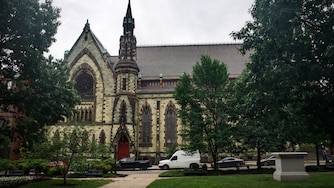Two organizations with ideas for redeveloping a vacant school property in the Westgate neighborhood of Baltimore are facing pushback from several residents.
An online petition asks Baltimore’s Department of Housing and Community Development to reject proposals made by the organizations and accept new ideas for the former school at 201 N. Bend Road.
Community Housing Partners, a nonprofit based in Virginia, pitched a plan to renovate the existing building with 120 affordable housing apartments and to build two other buildings for 48 additional units. They’d also include an outdoor courtyard and keep the current gymnasium for amenities and community use.
To Inspire Strong Families and Communities Foundation, a nonprofit headquartered in Washington, D.C., proposed an innovation center that would provide different government, local nonprofit and grassroots services. The foundation hopes to modernize the building and operate a network of partner-led programs. Some possible services could be child care, senior care, and dial-in mental health services.
Both organizations said, if selected, they would get the community’s input throughout the redevelopment process. The Department of Housing and Community Development also issued a survey to residents following the presentations.
“We bid on these sites because we believe we can deliver long-term value to the communities we serve, so we hope communities see that value and are excited to work with us to achieve it,” Dr. Ogay S. Irono, president of the To Inspire Strong Families and Communities Foundation, wrote in an email.
But some residents were still unhappy with the plans and would like the city to get additional proposals or ask for revised, more intentional approaches from the original proposals.
Community Housing Partners through a spokesperson declined to comment about the criticism because their proposal “is still in a competitive RFP process with the City of Baltimore.”
Ojeni Generette, a longtime Westgate resident, said she was not impressed with either of the presentations because they seemed generic and didn’t understand the neighborhood. Generette lives behind the building and attended a middle school that was once located at the building. She said affordable housing units might overwhelm the neighborhood, which already has a mix of housing options.
The services the foundation pitched, she added, didn’t align with the needs of the community. Irono said staff researched the building and the neighborhood and also reached out to local partners and representatives to inform their proposal. Generette would like to see the building used as an indoor sports complex or another recreational outlet for kids. An open space for vendors or a farmers market would be a benefit, too.
“I really think that the city needs to actually survey our neighborhood before they make any kind of decision on the proposals,” Generette said.
Other concerns with the proposals included environmental impacts, increased traffic and a lack of prioritization of green space. The Chesapeake Bay Foundation issued a letter to the housing department about the loss of green space with the Community Housing Partners’ plan. The letter specifically mentioned flooding, a major concern for the area, and how an increase in watertight surfaces can make it worse. Residents were displaced and roads were damaged in 2018 after nearby Frederick Avenue heavily flooded.
Jessica Sorrell, a parent of a local school student, said both proposals had some potential, but they didn’t consider the “huge opportunity” they had with the entire space. Community Housing Partners had expertise, she said, but she was concerned by the scale of residential units. The foundation, she added, mentioned some services that could fulfill a need, but the details were “fuzzy.”
“I would like to see them being asked to think more creatively,” she said.
The former West Baltimore Middle School building was built in 1963 and sits on a nearly 27-acre site that also includes North Bend Elementary/ Middle School. In the summer of 2015, the building became a temporary space for different schools, including Mary E. Rodman Elementary School and Frederick Middle School. The last school moved out in the summer of 2021.
The Broken Wall Project, a local faith community, partnered with the Neighborhood Design Center to get input from about 100 residents about what should be placed at the school. Those findings showed that a majority of people thought the space should be used for recreation or a multi-use community space. Reverend Ron Willoughby with Broken Wall said the process to sell the building seems to prioritize getting the building “off the city’s hands” and that it’s a “shortsighted” approach.
Kevin Nash, a public information officer with the housing department, said the community can give input about the selection process and neighborhood preference is always considered. The property is in the review panel stage, a process that can take up to nine months, depending on the circumstances of a request for proposals, according to Nash. Proposals are scored based on different categories like feasibility, the developer’s experience and benefits to the city and community. The scoring process helps provide the panel’s recommendation.
The department did not answer questions about whether the panel can generally ask for revised proposals.
Willoughby said regardless of what happens to the building, he hopes voices from the community are heard and considered.
“We want to see and uplift for our neighbors,” he said.




Comments
Welcome to The Banner's subscriber-only commenting community. Please review our community guidelines.